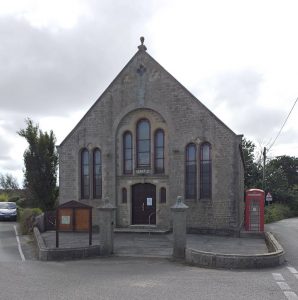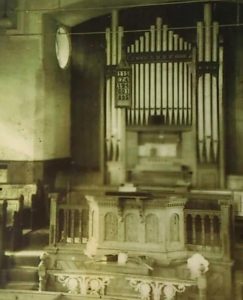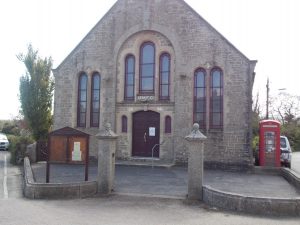Mapping Methodism – Barripper United Methodist Free Church
Categories Mapping Methodism, Projects0 Comments
Barripper is a village approximately one mile south-west of Camborne. This profile of Barripper United Methodist Free Church has been compiled by Jo Lewis and Tony Mansell.
The first United Methodist chapel in Barripper is recorded at this location on the 1st Edition 1:2500 1880 OS Map. By 1907 the new Free United Methodist chapel 138880 had been built on the main road to the south and this earlier chapel used as a Sunday school. Demolished. Only the chapel’s forecourt wall survives in front of a late C20 bungalow built on the site (b1). (Cornwall Heritage Gateway)
1860 Chapel
Located at 8-10 New Road.

“We descend the hill into the village of Barripper, a settlement that goes right back into the Middle Ages and which lay on one of the main roads through Cornwall and which was a pilgrim route to St Michael’s Mount, hence the name of the village hostelry.
As we walk west through Barripper we see ahead of us the imposing 1898 Methodist chapel, constructed as a United Methodist Free Church right at the end of the nineteenth century. It is however the second United Methodist chapel built in the village and not the first, so we will turn aside to the right in New Road to examine the original Free Methodist chapel which is now called the Old Sunday School and is situated between numbers 8 and 10 New Road.
Barripper was never really evangelised much by the Wesleyan Methodists, as their chapel had been built up the road at Adjewhella, as we have already seen. This meant that the Free Methodists were more or less given a free hand to proselytise for converts in the settlement, having formalised their 1849 secession from the Wesleyans in 1857.
We are really lucky that the first record book of the minutes and accounts of this early Barripper United Methodist Free Church chapel has survived, covering the period 1859 to 1868, preserved amongst the Circuit archives at Redruth. It makes illuminating reading. The first recorded meeting of the Trust was held at Brother Joseph Floyd’s house at Barripper on Wednesday 28 September 1859. The accounts also reveal that on 16 January 1860 the cost of building the chapel by Mr Kendall was £56 while providing a platform was a further £2 and altering the windows was £1. The building sat literally within a row of cottages that makes up the western facing residences in New Road. The chairman of the Trust meeting at that time was a William Quick while also present were John Eva, Joseph Floyd, James Stephens, W Jones, John Rodda, Edmund Prideaux, Edmund Trounson and William Quick. The newly constructed chapel was opened over a three-day period of services and meetings from Sunday to Tuesday 5th-7th February 1860. High rent of the property at eighteen shillings for two years was paid on 16 January 1860 while a chapel club was also formed to assist in the liquidation of the debt on the building, whereby people paid one shilling per month. There do not seem however to have been very many contributory members to this fund!. At this time the book also makes reference to the fact that there was a group of United Methodist Free Church prayer leaders working in the adjacent village of Penponds (where the Bible Christians had already built a chapel in 1844), as well as prayer leaders in Barripper itself. There is some fascinating detail. This newly built chapel remained in use as a place of worship until the new (the present) chapel was built on a different site in 1898 at the western end of the village. Presumably this was necessitated by the fact that it had become too small for the number of worshippers who wished to attend. Subsequently it became the Sunday School associated with the newer chapel but was of course later sold and became a private residence. If anyone has any further information about it I would be very pleased to hear about it. I do not have any interior pictures of it either as a chapel or a Sunday School. Our picture shows the premises as it is today in New Road blending in with the other houses. The average person who walks down New Road today would probably never guess that this structure, which has the appearance of a house, was once a place of Methodist worship. Indeed, the only clue is its Sunday School name.” (David Thomas)
1860: Build date.
Built as Barripper United Methodist Free Church.
16 January 1860: Accounts show the cost of building the chapel was £56.
Sunday to Tuesday 5th-7th February 1860: Newly constructed chapel opened over a three-day period of services and meetings.
1880: Maps show it as a United Methodist Chapel.
Chapel was used until it became too small and was replaced in 1898 by the newer chapel.
1898: Became the Sunday school.
1907: The front of Barripper chapel io being on- masonry, including some tine Cornish granite. (The Cornish Telegraph – Thursday 07 February 1907)
1908: Maps show it as the Sunday school.
1970s: Became a hall.
Became residential called The Old Sunday school.
1898 Chapel
Located in Fore Street
United Methodist Free chapel. Late C19. (Cornwall Heritage Gateway)




“Leaving the old Sunday School in New Road, Barripper behind us a short walk brings us to the present Methodist church in the village, (built in 1898 in the Gothic style as a United Methodist Free Church to replace the older chapel), which has a commanding presence and always catches the eye as one is driving down from the Camborne direction. There is an entrance courtyard which is accessed from between two beautiful granite gate posts. The chapel became a United Methodist Church in 1907 and a Methodist one in 1932.
The chapel’s archive at Redruth contains a baptism register commencing in the year 1886 so it therefore records christenings for 13 years which took place in the original chapel, as well as later entries up until 1941 in the new building. Trust minutes also commence in 1898 with the building of the newer place of worship. Up until the year 1976 the Society also operated a seat rent system for regular worshippers, which assisted with providing funds for the chapel. You paid for the use of your pew and theoretically no-one else was supposed to sit in it. The Methodist Church as a body gradually phased out this system in the 1960s and 1970s and this was a wise decision.
The Circuit preaching plan for the year 1960 records that at that time there were 26 members of the Society and that the Society Steward was a Mr W J Pearce of 6 New Road while the chapel Leaders were the same Mr Pearce and a T J Mitchell. Sunday services were held regularly at 11.00am and 6.00pm and occasionally also at 2.30pm.
In 1998, on the occasion of its Centenary, the interior of the chapel received a major makeover with the pews and organ being removed and chairs substituted. This provided a multipurpose worship and community space for the village. The church remains an active one within the Camborne-Redruth Methodist Circuit.
The first two pictures show the exterior of the building as it appears today looking from the eastern and southern directions.
The third photograph is an image from the early part of the twentieth century looking towards the organ, pulpit and choir pews. The light comes from the left into the organ chamber from a rather attractive oriel window. If you look closely on the top of the communion table below the pulpit there are two enormous, long handled collection boxes displayed. These were in use in many local chapels, including Pool Wesley, now the Light and Life Centre. With their long handles they would have been good for social distancing when the stewards received the offertory!! The fourth and last coloured picture shows the chapel interior before the 1998 alterations. The fine detail of the pulpit and communion rail can be appreciated and it can be noted that an attractive pulpit fall or desk cloth has appeared, along with a brass cross and flowers on the communion table. Also note the woodwork of the panelling on the wall behind the organ. (Thanks to David Philp of Hayle for these two internal pictures). Barripper is very much an example of how the interiors of places of worship can change over the generations. When such changes are made it is important to document, date and record them photographically for the record. (David Thomas)
1898: Build date.
Built as Barripper United Methodist Free Church.
1900: Barripper U.M.F.C. Chapel celebrated its first anniversary of the new chapel on Sunday, January 28th. (West Briton and Cornwall Advertiser – Thursday 08 February 1900)
1907: The Methodist New Connexion, Bible Christians and United Methodist Free Churches amalgamated to become the United Methodist Church.
1908: Became Barripper United Methodist Church.
1925: “Methodist Sunday school, Barripper, held their annual tea treat on Wednesday. After a march round the village, headed by the Camborne Town Band, under the direction of Bandmaster Parker, the scholars proceeded to a field kindly lent by Mr. Cappel.” (9 July 1925 – Cornubian and Redruth Times)
1998: On the occasion of its Centenary, the interior of the chapel received a major makeover with the pews and organ being removed and chairs substituted. This provided a multipurpose worship and community space for the village.
28 Mar 2006: Inspection certificate and summary quinquennial inspection report, Barripper Methodist Church, Camborne. With coloured photographs, report compiled by Kirk, Spurgin & Copeland, chartered building surveyors, 10 Symons Terrace, Redruth. Kresen Kernow MRCR/385)
 Barripper United Methodist Free Church (Photo: Paul Phillips)
Barripper United Methodist Free Church (Photo: Paul Phillips)
